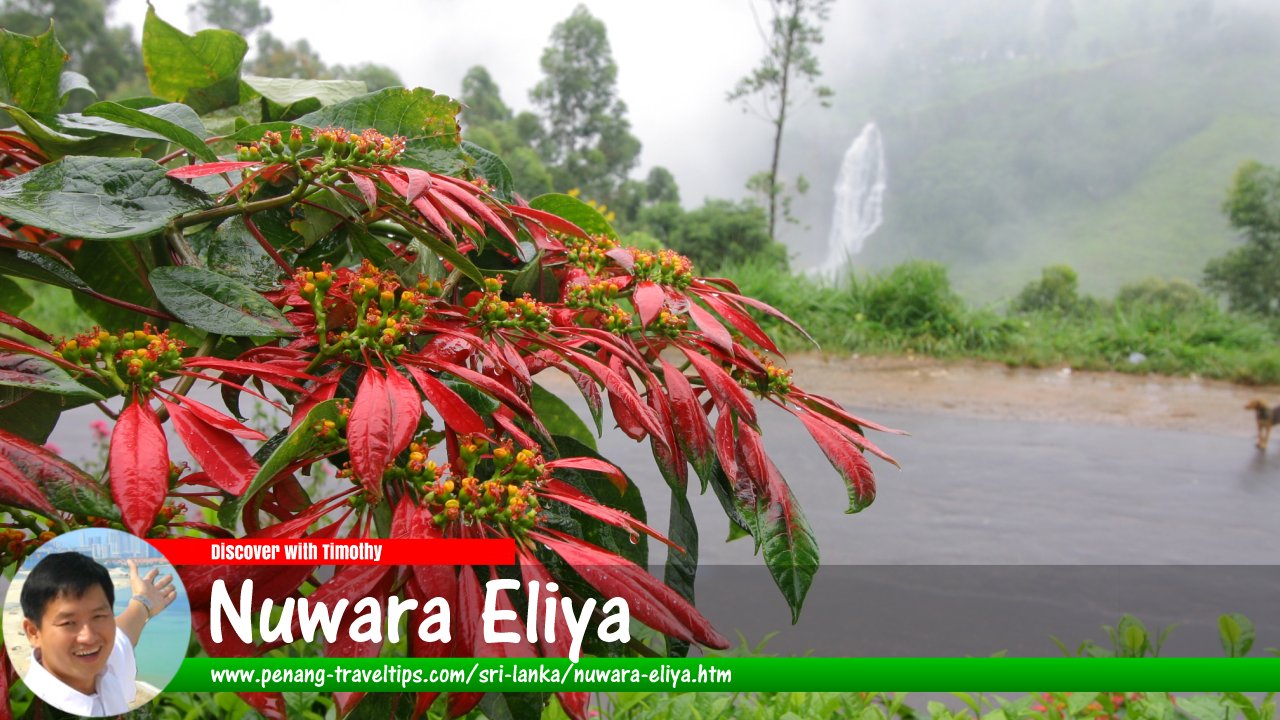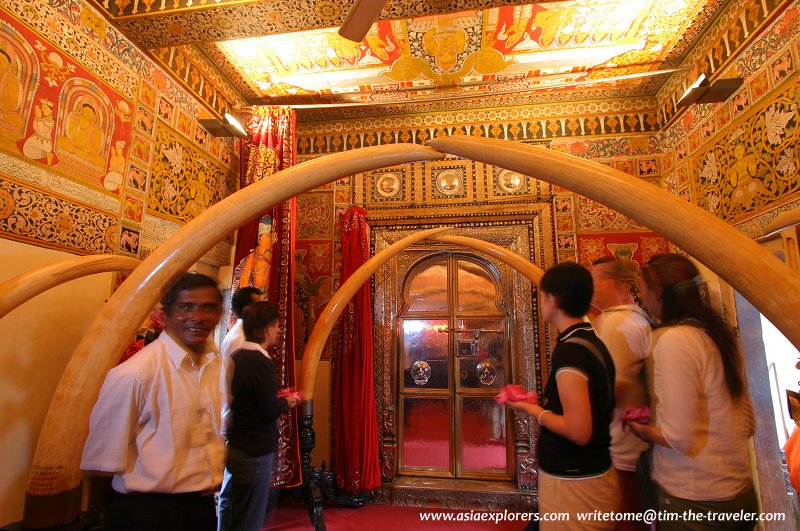 Buddhist members of AsiaExplorers at Sri Dalada Maligawa, awaiting to see the sacred tooth relic (31 August, 2005)
Buddhist members of AsiaExplorers at Sri Dalada Maligawa, awaiting to see the sacred tooth relic (31 August, 2005)
Sri Dalada Maligawa, or Temple of the Tooth Relic, is the holiest Buddhist temple in Sri Lanka. It is located in the city of Kandy, the ancient capital of the Kandyan kingdom.
During my visit to Kandy with a small group of AsiaExplorers members, I had the privilege not only to visit the temple, but also to enter the holy sanctuary. Our tour guide was able to arrange with the temple escort for us to be ushered to the inner sanctuary, a place where normal pilgrims would not have a chance to visit. Directly before us is the doorway to the holy of holies. However, as I am not a Buddhist, the visit is merely of cultural rather than religious value to me.
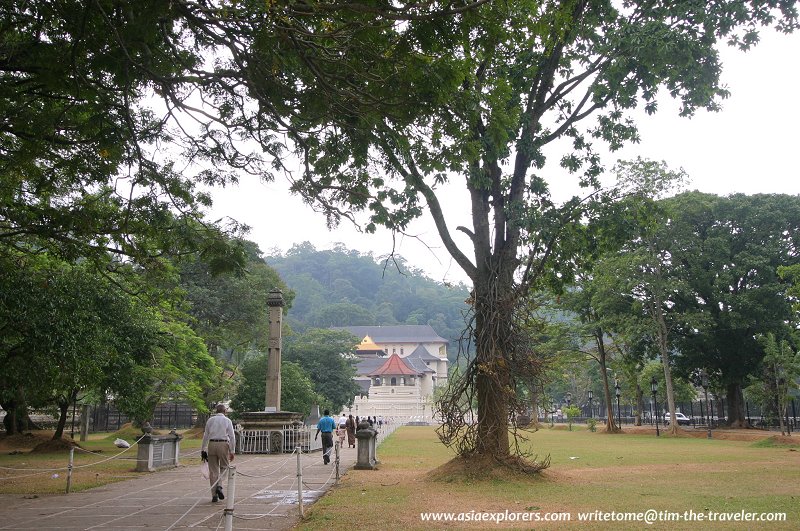 Sri Dalada Maligawa (31 August, 2005)
Sri Dalada Maligawa (31 August, 2005)
The The temple enshrines relics of what is believed to be the actual teeth of the Buddha. After Buddha was cremated, his four canine teeth were taken from the ashes. These teeth are regarded as the holiest relics of Buddhism. The worship of Buddha's remains has been going on throughout the centuries. It was recorded in the Mahaparinibbana-sutta (the Record of the Demise of the Buddha), and was sanctioned by the Buddha himself as he was about to die.
After the cremation, Buddha's relics were distributed among various kingdoms that sought them. The relics were enshrined in funerary mounds called the stupa. However, Buddha's four canine teeth were separately enshrined and worshipped. I am reporting here stuff which is a mixture of history and legend. According to what I have read, the right canine was worshipped by the king of gods, Sakra. Another tooth relic was worshipped by the king of Gandhara, which is located in modern-day Pakistan. The third tooth relic was taken away by the Nagas who worshipped it in a golden shrine room. The fourth, the left canine was given to the king of Kalinga in Eastern India.
 The Pathirippuwa, an octagonal library housing rare Buddhist manuscripts (31 August, 2005)
The Pathirippuwa, an octagonal library housing rare Buddhist manuscripts (31 August, 2005)
It's the fourth tooth, the tooth relic of the Kalinga, that is today enshrined at the Sri Dalada Maligawa in Kandy. It had become an object of great veneration by generations of Kalinga kings until it earned the wrath of brahmanical followers. Fanatical rulers attempted many times to destroy the Relic. Yet it miraculously survived all such atrocities. For this reason, many kings tried to get hold of it for personal veneration. The last Indian ruler to possess the Tooth relic was Guhasiva of Kalinga (c.4th century AD).
When a neighboring kingdom made war with Guhasiva to get hold of the Tooth relic, for its safety, the tooth relic was taken out of India. At that time, Buddhism was already well established in Sri Lanka, and the island's rulers maintained close relations with the Indian states that fostered Buddhism. So when the Kalinga ruler were under threat from loosing the teeth, he decided to send it to his friend, the king of Anuradhapura, the ancient Sri Lankan capital.
 Moat of the Sacred Tooth Relic Temple (31 August, 2005)
Moat of the Sacred Tooth Relic Temple (31 August, 2005)
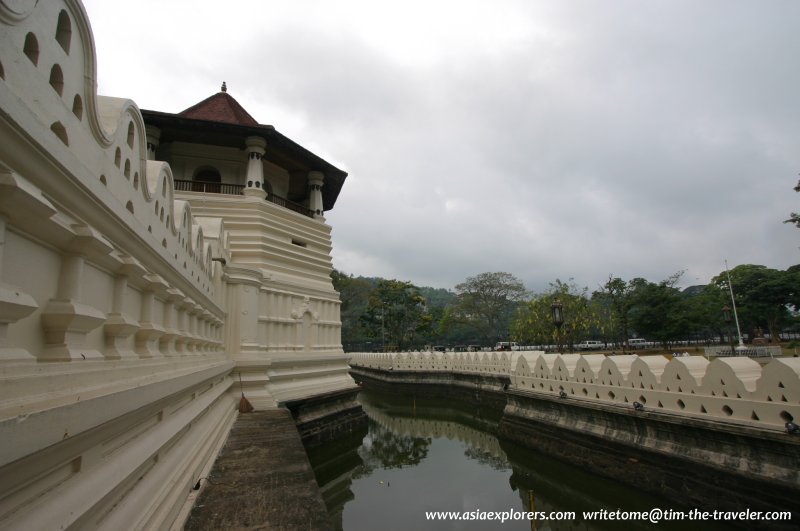 Another view of the moat at Sri Dalada Maligawa (31 August, 2005)
Another view of the moat at Sri Dalada Maligawa (31 August, 2005)
By the time the tooth relic arrived in Sri Lanka, the Sri Lankan king who was supposed to receive it had passed away, and the reign has passed to his son, King Kirti Sri Meghavanna. King Kirti Sri Meghavanna happened to be a pious Buddhist. He received the Tooth Relic and placed it on the throne with much veneration. He then built a special shrine for it.
The Tooth Relic was kept at the Abhayagiri Vihara in northern Anuradhapura from the 4th century until the end of the 10th century when the capital Anuradhapura was shifted to Polonnaruwa. Accounts of the tooth relic were documented by a travelling Chinese monk, Fa-Hsien, who recorded the worship and rituals connected with it.
 Passageway leading to the main sanctuary of the Sacred Tooth Relic Temple (31 August, 2005)
Passageway leading to the main sanctuary of the Sacred Tooth Relic Temple (31 August, 2005)
 Intricate stencils on the ceiling of the passage (31 August, 2005)
Intricate stencils on the ceiling of the passage (31 August, 2005)
When the South Indian Cholas invaded Anuradhapura, the Tooth Relic once again faced another period of risk and uncertainty. Nevertheless, it remained in the custody of the Anuradhapura rulers, until king Vijayabahu I shifted the capital to Polonnaruwa in the 11th century.
In Polonnaruwa, the Tooth Relic was housed in the Atadage in the Sacred Quadrangle (Dalada Maluva). It is identical to the Tooth Relic temple built by Vijayabahu. The Tooth Relic, together with the Bowl Relic (alms bowl), was brought down from the Uttaramula Ayatana monastery of the Abhayagiri Vihara and installed in the Atadage shrine.
 Temple dancers, Sri Dalada Maligawa (31 August, 2005)
Temple dancers, Sri Dalada Maligawa (31 August, 2005)
 Ornately embellished passageway at the outer sanctuary (31 August, 2005)
Ornately embellished passageway at the outer sanctuary (31 August, 2005)
 Courtyard at the outer sanctuary (31 August, 2005)
Courtyard at the outer sanctuary (31 August, 2005)
After King Vijayabahu's death, the kingdom went though a calamitous period, and many Buddhist shrines were destroyed. Fearing the destruction of the sacred Tooth and the Bowl Relics, monks secretly removed them to safer locations in the southern country, Rohana, and only returned it after King Parakramabahu I ascended to the throne in the year 1153 AD. With King Parakramabahu I came a renaissance in Buddhist religious activities.
The next great ruler to build a Relic shrine to house the sacred Tooth and Bowl Relics was Nissankamalla (1187-1196). Nissankamalla built the Relic Shrine Hatadage and, having offered his son and daughter to the Relics, redeemed them with the completion of the shrine. This edifice is situated next door to the Atadage, and is a larger version of the Atadage. You are able to view them all in AsiaExplorers pages on Polonnaruwa heritage sites.
 Staircase to the Inner Sanctuary (31 August, 2005)
Staircase to the Inner Sanctuary (31 August, 2005)
 Inner sanctuary, Sacred Tooth Relic Temple (31 August, 2005)
Inner sanctuary, Sacred Tooth Relic Temple (31 August, 2005)
 Waiting to view the sacred tooth relic (31 August, 2005)
Waiting to view the sacred tooth relic (31 August, 2005)
The glory of Polonnaruwa has started to wane by the beginning of the second quarter of the 13th century. When the Kalinga Magha invaded, the capital of the ancient Sri Lankan kingdom had to be shifted further south, to the south-western part of the country. The Tooth Relic and the Bowl Relic were once again spirited away by the monks for safekeeping. This time they were kept in Kotmale in the central hills.
When King Vijayabahu II ascended the throne, he had these relics taken down and enshrined in a building on the hilltop of Beligala. King Vijayabahu II was succeeded by his son, who took the throne under the name Parakramabahu II (1236-1270). An erudite scholar, Parakramabahu II complied some of Sri Lanka's classical literary texts, including the Kavusilumina.
 Throngs of worshippers at the Outer Sanctuary (31 August, 2005)
Throngs of worshippers at the Outer Sanctuary (31 August, 2005)
Parakramabahu II enshrined the relics near his palace at Damabadeniya rock. However, the Chandrabhanu of Java launched an invasion of Sri Lanka, shattering the peace and prosperity under Parakramabahu II. However, the king was able to expel the enemy and bring stability back.
According to legend, there was once a severe drought. The Tooth Relic was taken out of its shrine and a great procession was held for seven days. This ended the drought, and started the tradition of the Perahera Festival.
 Seated Buddha, Outer Sanctuary (31 August, 2005)
Seated Buddha, Outer Sanctuary (31 August, 2005)
During the reign of Parakramabahu II, his son Vijayabahu who was sub-king renovated and enlarged the Relic shrine and conducted great ritual services. As the chronicles recorded, he restored the ruined religious edifices at Polonnaruva, including the Tooth Relic shrine. After placing the Tooth Relic in the shrine, he conducted an a coronation ceremony for it. When Chadrabhanu of Java invaded ancient Sri Lanka for a second time, they defeated the local sub-ruler and demanded the tooth relic. However the Sri Lankan ruler was able to defeat them and once again the island was peaceful. When King Bhuvanekabahu came to power, he built a shrine for the sacred Tooth Relic at Yapahuva with a grand stairway. He continued the tradition of paying homage to the sacred Tooth Relic daily.
 Brass parasols, Temple of the Sacred Tooth Relic (31 August, 2005)
Brass parasols, Temple of the Sacred Tooth Relic (31 August, 2005)
Almost immediately after his reign, Sri Lanka was again faced with severe droughts. At the same time, the rulers of the Pandyan country in South India invaded under the great warrior Arya Cakravarti. He devastated Sri Lanka and plundered much of its wealth and treasure, taking with him the Tooth and Bowl Relics, which he handed over to the Pandyan king Kulasekera.
The next Sri Lankan king, Parakramabahu III, visited the Pandyan capital and after friendly discussions, managed to get back the Relics and initiated the traditional rituals. The king brought the relics back to Polonnaruwa and enshrined them at the old Tooth Relic shrine of the ancient capital which had been abandoned for some time.
 Visiting Pathirippuwa, the library of manuscripts (31 August, 2005)
Visiting Pathirippuwa, the library of manuscripts (31 August, 2005)
 The rare manuscripts (31 August, 2005)
The rare manuscripts (31 August, 2005)
According to Marco Polo, Kublai Khan sent a messenger to obtain the Tooth, Hair and Bowl Relics from the Sri Lankan king. However, the king was able to please the Chinese Emperor by dispatching two fake teeth, which were graciously received by the Emperor who established ritual worship of the objects.
King Bhuvanekabahu II (1293-1312) brought the Tooth Relic from Polonnaruwa and placed it in a shrine at his capital, Kurunagala. Under the next ruler, Parakramabahu IV, there was a religious revival. King Parakramabahu IV reorganized the rituals connected with the sacred Tooth Relic in a systematic manner as recorded in the text Dalada Sirita.
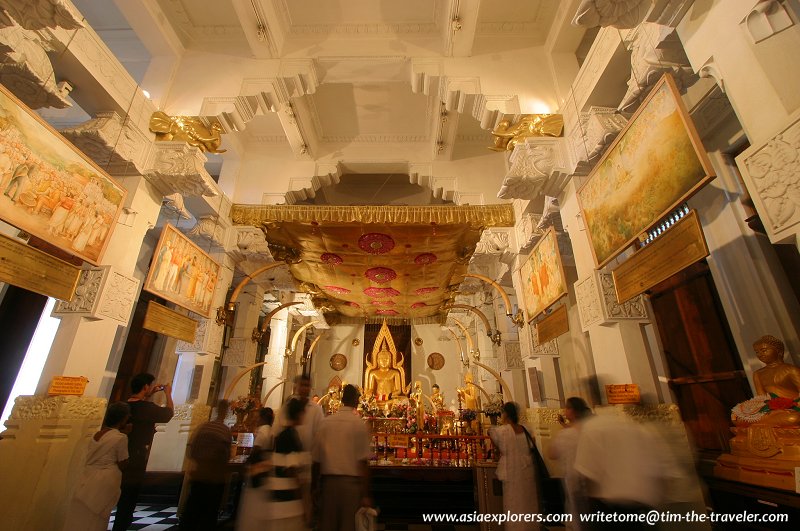 Prayer hall at the Tooth Relic Temple (31 August, 2005)
Prayer hall at the Tooth Relic Temple (31 August, 2005)
The next ruler, King Bhuvanekabahu IV, selected a new capital, Gampola, in the central hills. However, it wasn't mentioned whether he brought the tooth relic into the new city. In all possibility, it was King Vikramabahu III who shifted the relic to this hill capital and held a festival in honor of it. He is credited with the building of the shrine at Niyangampaya in Gampola.
The next king, Bhuvanekabahu V (1372-1408), shifted the capital to Jayavardanapura Kotte which is closer to Colombo. Although he did not bring the tooth relic to his capital, he conducted many ritual performances for it. His successor, King Virabahu, brought down the tooth relic to Jayavardanapura Kotte.
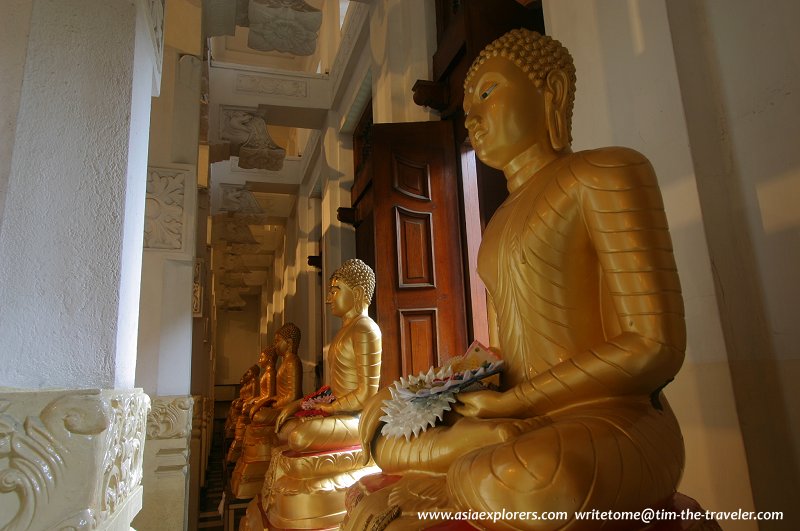 Buddha statues at the prayer hall (31 August, 2005)
Buddha statues at the prayer hall (31 August, 2005)
During King Virabahu's reign, the great Chinese eunuch Zhenghe (Admiral Cheng Ho) arrived in Sri Lanka. He took the king and his family and presented them to the Chinese emperor of the time. Conflicting reports documented that the tooth relic was also taken to China, or that it was left on the island. In all likelihood, the tooth relic did not leave, for subsequent reports documented of processions, festivals and rituals conducted by later rulers like Parakramabahu VI. He is said to have built a three-storey shrine for the tooth relic and had four golden caskets enveloping it.
The subsequent period saw the arrival of the first colonial power, the Portuguese, in 1505. This brought about a deterioration inn Buddhist activities. Missionary activities by the colonial powers made the Buddhist monks nervous, and they secretly spirited away the relics to safer locations. Thus, the relic was shifted to the next kingdom, Sitawaka, ruled by King Mayadunne. Prior to bringing the tooth relic to Ratnapura, it was taken as far south as the Mulgirigala Vihara and then to the Ridivihara in the Kurunegala District. The Tooth Relic was finally hidden in a cairn in the Delgamuva Vihara in Ratnapura. It was from this temple that the Tooth Relic was finally brought to its present resting place in Kandy, by King Vimaladharmasuriya I (1592-1603).
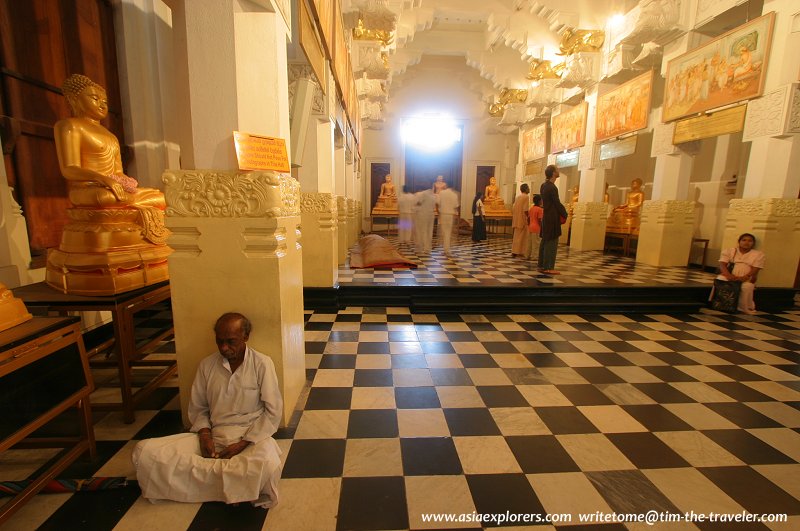 Interior of the prayer hall (31 August, 2005)
Interior of the prayer hall (31 August, 2005)
 Ceiling of the Prayer Hall, Sri Dalada Maligawa (31 August, 2005)
Ceiling of the Prayer Hall, Sri Dalada Maligawa (31 August, 2005)
King Vimaladharmasuriya I built a new three-storey shrine for the relic near to the royal palace. The Dutch Plan of 1765 shows the ground plans of two shrines. The one at the back should be the original one built by the king. When King Vimaladharmasuriya I died, the kingdom was again plunged into difficult times. Finally King Senarat (1603-1634), the king's brother, occupied the throne. He had to face severe opposition from other contenders to the throne. As a result, the king has to live at a remote place in Mahiyangana. He took the tooth relic to a safe location at Madamahanuvara in the hills enveloped with thick forest cover. Even under these difficult conditions, King Senarat was able to place the relic in a suitable shrine.
King Rajasimha II (1634-1686) succeeded King Senarat. At that time, the Portuguese was intensifying their interference in local politics. King Rajasimha sought the aid of the Dutch, despite objection from the people. The political climate was so turbulent that the annual Tooth Relic festival was disrupted.
 Pavilion on the grounds of the Tooth Relic Temple (31 August, 2005)
Pavilion on the grounds of the Tooth Relic Temple (31 August, 2005)
The next king was Vimaladharmasuriya ll (1686-1706). He was able to maintain harmonious relations with the Dutch and attend to many religious activities. He built a new three-storey relic house. The king also prepared a grand golden casket for the sacred Tooth Relic and held great festivities in honor of tooth relic. The next king was Viraparakrama Narendrasimha (1707-1739). He was the last Sinhalese king. King Narendrasimha rebuilt the Tooth Relic shrine.
A recent bomb blast by the Tamil Tigers caused much damaged to the Dalada Maligawa, but the shrine known as Vadahitina Maligava was miraculously saved.
 Visitors exiting the Tooth Relic Temple (31 August, 2005)
Visitors exiting the Tooth Relic Temple (31 August, 2005)
 Members of AsiaExplorers cooling off at the ablution pool after visiting the Tooth Relic Temple (31 August, 2005)
Members of AsiaExplorers cooling off at the ablution pool after visiting the Tooth Relic Temple (31 August, 2005)
 Latest updates on Penang Travel Tips
Latest updates on Penang Travel Tips
 Destination Sri Lanka
Destination Sri Lanka
Major Tourist Attractions of Sri Lanka

Copyright © 2003-2025 Timothy Tye. All Rights Reserved.

 Go Back
Go Back


